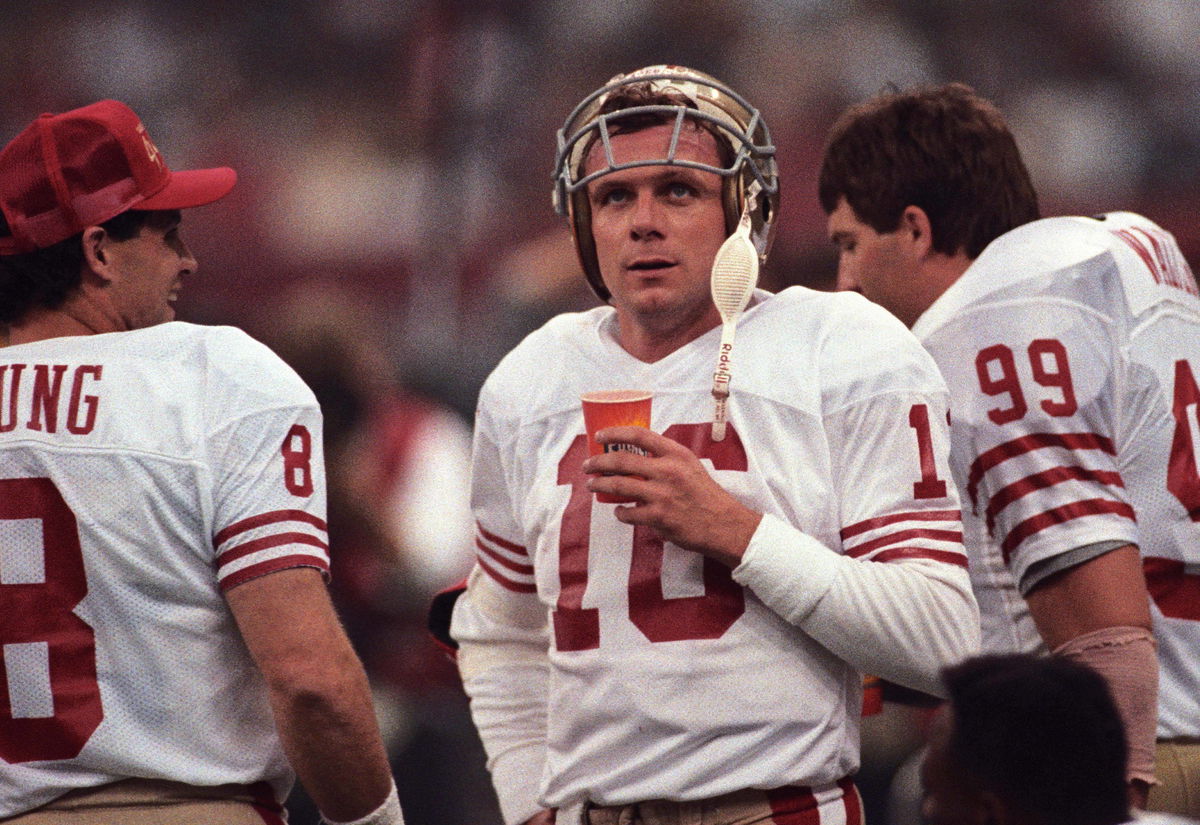
Imago
NFL, American Football Herren, USA Super Bowl XXIV Jan 28, 1990 New Orleans, LA, USA FILE PHOTO San Francisco 49ers quarterback Joe Montana 16 on the sidelines with quarterback Steve Young 8 against the Denver Broncos during Super Bowl XXIV at the Superdome. The 49ers defeated the Broncos 55-10. New Orleans Louisiana UNITED STATES, EDITORIAL USE ONLY PUBLICATIONxINxGERxSUIxAUTxONLY Copyright: xBobxDeutschx 8949027

Imago
NFL, American Football Herren, USA Super Bowl XXIV Jan 28, 1990 New Orleans, LA, USA FILE PHOTO San Francisco 49ers quarterback Joe Montana 16 on the sidelines with quarterback Steve Young 8 against the Denver Broncos during Super Bowl XXIV at the Superdome. The 49ers defeated the Broncos 55-10. New Orleans Louisiana UNITED STATES, EDITORIAL USE ONLY PUBLICATIONxINxGERxSUIxAUTxONLY Copyright: xBobxDeutschx 8949027
The late 80s were awkward for the 49ers’ QBs. Joe Montana and Steve Young coexisted under head coach Bill Walsh’s leadership while doing the job of just one person. The only difference was that Montana was already established, while Young was still trying to get his foot in the door. Yet, it was the former’s veteran presence that gave the leadership the perfect tool to shape Young’s growth. How, you may ask?
Watch What’s Trending Now!
Well, Seth Wickersham, a reporter and author of American Kings: A Biography of the Quarterback, shared a tale from back in the day—one that suggests that sticking to the playbook isn’t always the best. He was on the Dan Patrick Show, where he recalled: “It’s interesting to see Steve Young when he was sort of taking over for Joe Montana. He had this moment where he was playing really well… But he wasn’t Joe. Mike Shanahan [OC] had come along, and he spent two days with every quarterback; and Montana was still with the 49ers, but was injured.” That’s when a twist took place.
“And after spending time with Joe Monatana, he called Joe back, and he was like, ‘Joe, you look at the West Coast Offense differently than anybody. Like, I need to understand how you think about this.’ And Joe was like, ‘Yeah, I was hoping you wouldn’t notice that.’ And as it turns out, Joe was this incredible practitioner and radical simplifier.”
ADVERTISEMENT
Montana wouldn’t run the West Coast Offense exactly the way Walsh wanted. Instead, he would narrow it down to just one receiver. If the receiver was there, he would look at a second option, but if that too wasn’t available, he would throw the ball away. On the other hand, Young would do exactly as Walsh drew, and in the process, he would get hit unnecessarily. The author continued, “So, the year after Joe Montana was traded to the Chiefs, Mike Shanahan called Steve Young back in and was like, ‘Alright, we are changing the way the offense runs. We are not doing it by the playbook again.”
Shanahan benefited a lot from that discussion with Montata. Here’s why. Walsh, during his term with the Bengals and the 49ers, developed the WCO, which was a system of short and accurate passes. And after the then-HC retired from San Francisco, the new HC, George Seifert, continued using it, and so would Shanahan for the rest of his career as a coach.
In fact, Shanahan went on to be known for running the system off of a single formation, and also the same plays through multiple formations. The system drove defenses crazy, though it lacked pizzazz. It was helpful in creating mismatches, overloading zones, and exploiting holes in the defense. And while this may be common in structures today, back in the day, it was an innovation in the pro game.
ADVERTISEMENT
That explains why Montata nudged Shanahan to think outside the playbook. It was for the best. At least, Steve Young would agree. After playing 15 seasons in the NFL, 13 of which were under the 49ers’ West Coast Offense, Young once mentioned, “The offense cannot be taught or run based solely on a playbook. If a coach has no history in the West Coast and wants to teach it based on a playbook, he wouldn’t get it.”
ADVERTISEMENT
ADVERTISEMENT
ADVERTISEMENT

